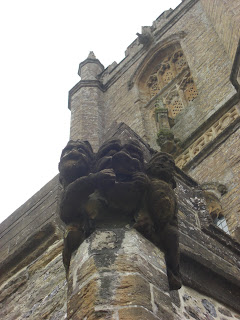A few friends of mine from the Goth world attended
White Mischief a couple of nights before Halloween. White Mischief has been a predominately Steampunk event since 2008 but the last outing had (so I'm led to understand) a considerable dollop of music that has come to be called Electro-Swing, some of which,
some of which I stress, I find myself quite fond of as well.
How people come across new genres and styles is always interesting. In my case I was sojourning with my parents over Christmas in 2008 and caught the festive edition of
Jonathan Creek which featured in a garden party scene a trio of close-harmony singing ladies in vintage hairstyles. These were the
Puppini Sisters whose Myspace profile I swiftly looked up. The song they were singing was 'Spooky', and they also did (and do) both covers of modern pop and classic songs from the swing and big-band era in a fairly staightforward style - though their version of 'Boogie Woogie Bugle Boy from Company B' is so fast, a full
minute quicker than the Andrews Sisters', that some vintage fans can't take it. Some of their stuff, however, came under the category they themselves, lacking any other label at the time, referred to as 'swingpunk': music that took a swing-era idiom and updated it with modern rhythm and production. 'Crazy in Love', with its initial sample of 'Puttin' on the Ritz', was a prime example. Eventually I got around to buying a couple of their albums on Amazon, which, in its helpful way, suggested I have a look at
White Mink/Black Cotton as well.
 Obviously
Obviously what caught my eye was the reference to the iconic ER Richée photograph of Louise Brooks, 'Kansas Cleopatra'. What caught my
ear when I actually listened to it, however, was a number of pieces that, like 'Crazy in Love', melded vintage music samples (and sometimes more sophisticatedly musical motifs played in a vintage style) with contemporary instrumentation. In particular I found myself rather adoring Gry and FM Einheit's 'Princess Crocodile' and 'Jolie Coquine' by Caravan Palace. I now know that
White Mink/Black Cotton was crucial in consolidating and spreading the whole idea of Electro-Swing beyond a few experimental tracks and turning it into a genre.
Of course it's begun taking off hugely and feeds into the burgeoning vintage scene as well. A lot of electro-swing is heavy and strongly rhythmic, and can be seen as a close relative of house or hiphop, but Caravan Palace and other bands do play real instruments. I've just come across Michael Biboulakis and Nina Zeitlin's
'Is That Too Much To Ask' which, as well as the heavy beat, features a clarinet, bass and trumpet/. The closer an interest you take in the music of the past, of course, the bigger the temptation is to adopt other aspects of the past's styles too, especially when there are pre-existing organs such as
The Chap encouraging you to do so. Have a look at
Caravan Palace's video for their second single, 'Suzy', to see how they succumbed. It's rather gorgeous.
'After an evening of Steampunk and Electro-Swing it's good to get back to Goth basics', commented a friend on Facebook after coming home from White Mischief, linking one feels with some relief to an online deathrock radio station. Other Goths can't get enough of the stuff; another friend talks of 'rescuing electro-swing from the house crowd'. I suspect it's the genre's tongue-in-cheek quality which appeals so strongly to the mischievous side of Goth as well as its creativity and references to the past, and elides very smoothly into other varieties of dark-tinged music such as Sepiachord and Dark Cabaret: compare both the sound and look of
The Scarring Party performing 'No More Room' and the
Diablo Swing Orchestra, for instance.
On its edges Electro-Swing goes very poppy, and shades into some of
Caro Emerald's brilliant output, most notably 'That Man' which I've even heard being played on Radio Co-Op in the local Swanvale Halt branch; or
The Correspondents who, I'm afraid, are slightly too soft for my tastes. This is bound to make Goth fondness for it a controversial matter in the scene. But we've been there before, and will be again.












































